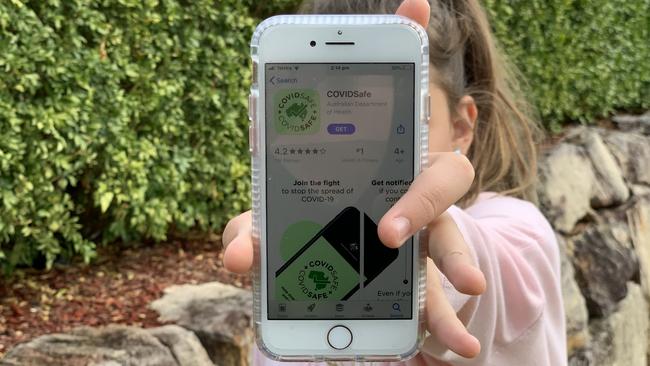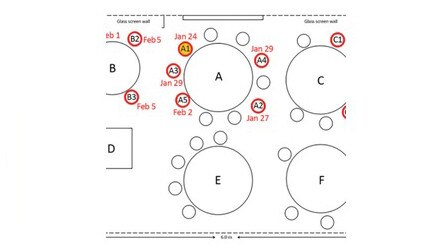Coronavirus: We need our own virus rule book as we exit lockdown

It’s Chris’s rules: my personal dos and don’ts for avoiding the virus out and about. My rules don’t contradict public health advice, but add to it. They are for me and no one else.
We’re entering a new phase. As the lockdown unravels, it becomes desirable for older and medically vulnerable people to adopt measures that are tougher than relaxed government demands.
The government’s aim is to finely balance minimising coronavirus with reviving the economy, but for many, the imperative remains to never contract COVID-19 and never be at its mercy should it spread to air passages and lungs.
Take the new rules here in NSW. Cafes, restaurants, bars and pubs can have 10 patrons who practice social distancing. I love cafes and having coffee so this sounds great, but I’m likely always to choose tables outside unless there’s ample fresh air circulating inside.
I’ll be avoiding public transport, except maybe very early morning, at night or occasions where there are few patrons aboard. In general I’ll avoid being with others indoors for any significant time. I feel sorry for frontline health workers, doctors, dentists, teachers, and aged care workers all of whom have little or no choice here.
I’ll also seek to minimise using lifts in public buildings. While lifts and other facilities are being thoroughly cleaned, there is the prospect of contracting COVID-19 from lingering aerosol droplets.
National Health and Medical Research Council professor of global biosecurity Raina MacIntyre told The Australian this week that studies showed the virus could be “aerosolised” and hover in the air, “in one study up to three hours and in another study up to 16 hours”, so extreme caution indoors seems warranted. (Choirs and ensembles have been seeking clarity on whether it is safe to sing at rehearsals, in churches and at concerts.)
I asked eminent virologist at UNSW Professor Peter White what he thought about a personal rule book for the pandemic. “Older people are going to be more conservative. It’s their idea about coming out of lockdown, which I think is valid and good,” he said.
White himself is playing it safer, not allowing his elderly parents to go shopping for a couple more weeks. Even though they could go themselves, he shops for them.
I’ve heard this view elsewhere. A friend said they will not allow their child to attend school until they see the result of schools reopening and whether the virus resurges. That could take a fortnight or more due to the incubation period.
White says life could be more dangerous now. People generally might not practise the degree of hygiene and physical distancing they did during lockdown.
Lockdown creep
“It’s called lockdown creep. Everyone’s had enough. It’s human nature,” he says. “This does concern me because it’s the old people who are going to bear the brunt. We’re looking at the possibility of a second wave. The question is how big is that second wave,” he says, adding that late 50s onwards is a risk factor.
An online article by US researcher Erin Bromage at the University of Massachusetts Dartmouth argues that the biggest danger is enclosed spaces.
While social distancing can work outdoors, and exercising in the local park is relatively safe, other factors are at play indoors such as air circulation, and time spent nearby others.
A person sitting at the next table a few metres away could infect you over a lengthy period indoors, while an infected jogger fleetingly passing you in open air might not have time to pass a sufficiently large viral load.
“There’s always going to be a danger in going into an enclosed space, which includes restaurants and cafes,” says White. “Airconditioning is going to be wafting air around. Cafes are not like planes and ships where they use HEPA (high-efficiency particulate air) filters and other sophisticated filters to filter out viruses. In cafes the viruses can be recirculated,” he says.

“Indoors is a lot, a lot more risky than outdoors.”
So rugging up and enjoying coffee and cakes with friends at outdoor cafe tables or in my local park might be what I do.
Then there’s transport. White’s view is that the big travel hubs in Europe with vast amounts of the population catching planes and trains was a big factor in the severe spread of the virus there.
Indeed crowded transport is worth avoiding, a theme the NSW government is taking up.
Transport solution
My solution is to continue commuting on an eBike, something I already do. The reported surge in bicycle sales in Australia shows that others are thinking the same.
I am concerned about flying, with Qantas and presumably soon other airlines rejecting the option of empty seats to preserve social distancing. However car getaways with those you live with seem a great option.
Then there are shopping centres. Given the fleeting nature of contact with others, shops should pose less of a risk if you maintain social distancing, although one Australian man died apparently after only two trips to the shops. Handling goods in supermarkets poses a risk.
White’s School of Biotechnology and Biomolecular Sciences at UNSW has prepared a flyer which deals with avoiding infection at shopping centres. Its recommendations include not using or handling cash, avoiding crowded areas, wiping down trolleys and not touching your face before resanitising your hands.
Home deliveries, however, remain the simplest way of avoiding these complications.
Coronavirus app
The Australian has been critical of the government’s COVIDSafe app. Concerns include the way data is managed centrally, privacy and the possibility of data being hacked through Bluetooth connections.
While there are privacy concerns, the government’s locking in of privacy protections in biosecurity law plus the revelation that many of us have Bluetooth constantly running suggests the risk isn’t so great compared with the benefit that the app could offer.
But will enough Australians install the app? The government originally cited a requirement of 40pc of the population (10 million), but the rhetoric has shifted to coverage of 40pc of adult phone users.
“The Chief Medical Officer made the point that there are about 18 million Australians over the age of 18 and 83 per cent have a mobile device,” said government Services Minister Stuart Robert. “So of 16 million, 40 per cent is around 6.2 million … we’re already at 5.8 million.”
This change doesn’t exude confidence given that it suggests the uptake of 19 million Australians isn’t necessary for the app to be effective.
Some states are yet to leverage data being generated by the app, which isn’t a calamity as there are few new infections for COVIDSafe to trace, although it has already helped contact tracing in Victoria.
The app’s true value will be better assessed in the months ahead where we have significant outbreaks before we have a vaccine.
I have installed the app despite my reservations and many Australians are committed to it and are willing to give the government the benefit of the doubt that it can get COVIDSafe fully working.
The government has advertised the app widely, but hasn’t fully articulated its health benefit.
For example, it hasn’t homed in on its ability to help eliminate a third generation of an outbreak.
If a spot outbreak occurs and person A infects person B, and then person A tests positive, the app can aid contact tracers to more quickly find person B and stop them infecting others, possibly before B is infectious. There is therefore less chance of an infected person C.
Quickly shutting down outbreaks will be part and parcel of keeping Australians out of further lockdowns.
The government needs to get this app running smoothly on iPhones and iron out bugs to keep the public’s confidence. We are yet to see if it can provide accurate contact data; there’s a way to go.
There’s also plenty of time for the government to consider whether it should swap to the Apple/Google system with its better privacy solution. Despite major concerns about Google and its abysmal privacy record, there is a degree of confidence that these two tech giants combined will get app tracing working properly, if anyone is to manage it.
We may need an app for more than a year.
For the most part, Australians want the app to work and want the government to get going with fixes.
In the end, with government restrictions gearing towards improving the economy, we need our own rule books for negotiating this virus and for keeping it totally at bay.
Our strictness beyond government regulations will depend on the energy we individually spend to avoid the virus. It’s no longer just us versus the state when deciding what we can and can’t do in the pandemic.







We have the Prime Minister’s rules and the Premiers’ rules on coronavirus restrictions, but there’s another rule book in the making.